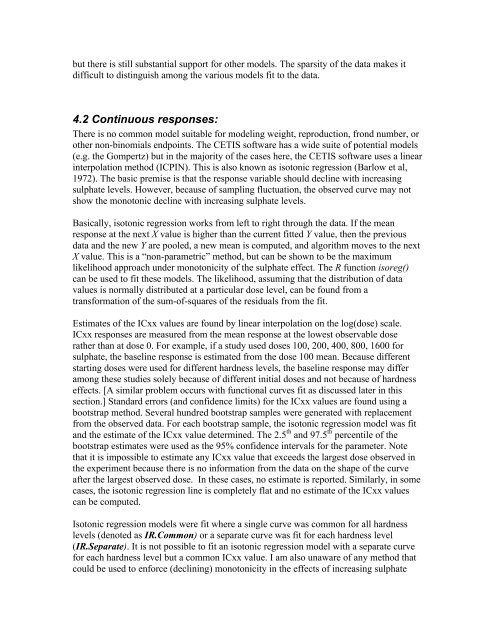Summary - People.stat.sfu.ca - Simon Fraser University
Summary - People.stat.sfu.ca - Simon Fraser University
Summary - People.stat.sfu.ca - Simon Fraser University
Create successful ePaper yourself
Turn your PDF publications into a flip-book with our unique Google optimized e-Paper software.
ut there is still substantial support for other models. The sparsity of the data makes itdifficult to distinguish among the various models fit to the data.4.2 Continuous responses:There is no common model suitable for modeling weight, reproduction, frond number, orother non-binomials endpoints. The CETIS software has a wide suite of potential models(e.g. the Gompertz) but in the majority of the <strong>ca</strong>ses here, the CETIS software uses a linearinterpolation method (ICPIN). This is also known as isotonic regression (Barlow et al,1972). The basic premise is that the response variable should decline with increasingsulphate levels. However, be<strong>ca</strong>use of sampling fluctuation, the observed curve may notshow the monotonic decline with increasing sulphate levels.Basi<strong>ca</strong>lly, isotonic regression works from left to right through the data. If the meanresponse at the next X value is higher than the current fitted Y value, then the previousdata and the new Y are pooled, a new mean is computed, and algorithm moves to the nextX value. This is a “non-parametric” method, but <strong>ca</strong>n be shown to be the maximumlikelihood approach under monotonicity of the sulphate effect. The R function isoreg()<strong>ca</strong>n be used to fit these models. The likelihood, assuming that the distribution of datavalues is normally distributed at a particular dose level, <strong>ca</strong>n be found from atransformation of the sum-of-squares of the residuals from the fit.Estimates of the ICxx values are found by linear interpolation on the log(dose) s<strong>ca</strong>le.ICxx responses are measured from the mean response at the lowest observable doserather than at dose 0. For example, if a study used doses 100, 200, 400, 800, 1600 forsulphate, the baseline response is estimated from the dose 100 mean. Be<strong>ca</strong>use differentstarting doses were used for different hardness levels, the baseline response may differamong these studies solely be<strong>ca</strong>use of different initial doses and not be<strong>ca</strong>use of hardnesseffects. [A similar problem occurs with functional curves fit as discussed later in thissection.] Standard errors (and confidence limits) for the ICxx values are found using abootstrap method. Several hundred bootstrap samples were generated with replacementfrom the observed data. For each bootstrap sample, the isotonic regression model was fitand the estimate of the ICxx value determined. The 2.5 th and 97.5 th percentile of thebootstrap estimates were used as the 95% confidence intervals for the parameter. Notethat it is impossible to estimate any ICxx value that exceeds the largest dose observed inthe experiment be<strong>ca</strong>use there is no information from the data on the shape of the curveafter the largest observed dose. In these <strong>ca</strong>ses, no estimate is reported. Similarly, in some<strong>ca</strong>ses, the isotonic regression line is completely flat and no estimate of the ICxx values<strong>ca</strong>n be computed.Isotonic regression models were fit where a single curve was common for all hardnesslevels (denoted as IR.Common) or a separate curve was fit for each hardness level(IR.Separate). It is not possible to fit an isotonic regression model with a separate curvefor each hardness level but a common ICxx value. I am also unaware of any method thatcould be used to enforce (declining) monotonicity in the effects of increasing sulphate
















